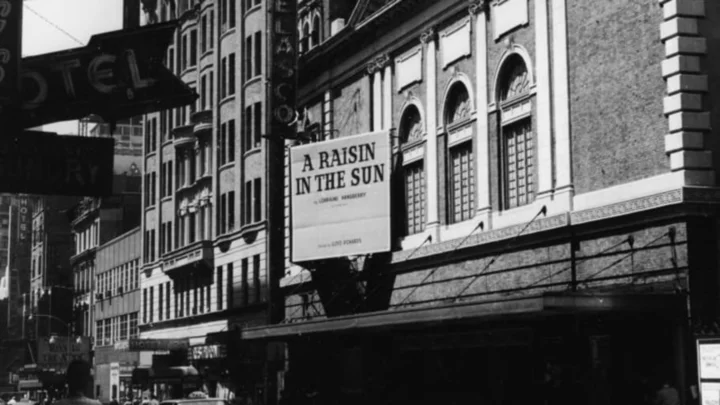By the age of 34, Lorraine Hansberry was already the author of two plays that had appeared on Broadway—Raisin in the Sun (1959) and The Sign in Sidney Brustein’s Window (1964)—and should have been on course for a long and successful career. Tragically, that wouldn’t happen due to her death from cancer on January 12, 1965. But Hansberry’s legacy has endured: As Martin Luther King Jr. said in a message sent to her memorial, she has remained “an inspiration to generations yet unborn.” Here are seven facts about the renowned writer and civil rights activist.
1. Lorraine Hansberry’s family was involved in the landmark 1940 case Hansberry v. Lee.
When Hansberry was 7, her father Carl bought a house in Chicago’s Washington Park neighborhood, which had a restrictive covenant banning Black people from purchasing property. Some residents—including a woman named Anna M. Lee—took legal action to try to kick the Hansberry family out. The courts initially ruled in favor of Lee, but Carl and his wife Nannie appealed the decision to the U.S. Supreme Court, where they were represented by Earl B. Dickerson. The decision was reversed—though, as the Library of Congress points out, “not because the court ruled that discriminatory covenants were unconstitutional or illegal” but “because the interests of the parties in Hansberry were not adequately represented in” a separate agreement that the previous courts had used as precedent.
While restrictive covenants were allowed to continue for some time after the Hansberry case, it’s still regarded as important because it paved the way for 1948’s Shelley v. Kraemer, which finally put an end to racially restrictive covenants by ruling that they were in violation of the Fourteenth Amendment’s equal protection provision. Today, the Hansberry family building is a Chicago landmark, and the experience would later inspire Hansberry’s play, A Raisin in the Sun.
2. Hansberry studied art.
Before she began her career as a dramatist, Hansberry studied art at three institutions: the University of Wisconsin-Madison, where she took art classes in 1948 but left before graduating; the University of Guadalajara in Mexico, where she took a painting-focused workshop in 1949; and Chicago’s Roosevelt University, where she had more art classes in 1950. Even after she began to focus on writing, Hansberry continued to create art in her spare time; here’s a self-portrait from 1952.
3. She wrote her first dramatic works during her time at the Black newspaper Freedom.
A new chapter in Hansberry’s life and career began when she started working at Freedom, a Black newspaper founded by Paul Robeson and Louis Burnham, in 1951. Her work included an article about Sojourners for Truth and Justice, an organization of Black women campaigning for their rights, and a report about the case of Willie McGee, a Black man who was executed in a “legal lynching” following his conviction for the rape of a white woman in Mississippi. During her time there, Hansberry also began to write dramatic works, including a collaboration with fellow Freedom contributor Alice Childress: a pageant celebrating Black life over the course of history. It was performed on February 29, 1952 at Harlem’s Golden Gate Ballroom with a cast including Childress, Robeson, Sidney Poitier, and Beulah Richardson; Harry Belafonte also sang at the event.
4. Hansberry’s play A Raisin in the Sun was the first play by a Black woman to appear on Broadway.
In 1959, Hansberry's play A Raisin in the Sun opened on Broadway, the first play by a Black woman to do so. The title comes from the opening lines of Langston Hughes’s poem “Harlem” which reflects on what happens to “a dream deferred”: “Does it dry up like a raisin in the sun?”
The play was a huge success, running on Broadway for 19 months. Author James Baldwin later wrote, “never before, in the entire history of the American theater, had so much of the truth of Black people’s lives been seen on the stage.” Two years later, A Raisin in the Sun was made into a film, for which Hansberry wrote the screenplay. The play remains a major milestone and continues to be performed to this day.
5. She wrote letters to The Ladder magazine on LGBT issues.
Hansberry was gay, but although she discussed her sexuality with some in her private life, according to The New Yorker, “it was never a public matter in her lifetime”— she lived in New York, where homosexuality was then illegal. “She wasn’t out in the traditional sense,” Hansberry biographer Imani Perry told NPR in 2018. “It would have been very difficult and dangerous for her to be out in multiple ways.” Hansberry began dating women after she separated from her husband, theater producer Robert Nemiroff, in 1957. (The pair, who had married in 1953, officially divorced in 1962, but remained close friends until her death.)
Hansberry wrote letters (signed with her initials only) to The Ladder, the first lesbian publication to have national distribution in America. In one letter, she described the conflict she experienced as a lesbian in a marriage to a man. After Hansberry’s death, Nemiroff donated her papers to the New York Public Library, but restricted all access to documents that included Hansberry discussing her sexuality; these papers only became available to the public in 2013.
6. Hansberry confronted Robert F. Kennedy about the need for him to make a moral commitment to civil rights.
Hansberry was deeply committed to the civil rights movement. She once wrote that “one cannot live with sighted eyes and feeling heart and not know and react to the miseries which afflict this world.” On May 24, 1963, Hansberry was present at what is known as the “Baldwin-Kennedy meeting,” where then-Attorney General Robert F. Kennedy sat down with James Baldwin and a number of other leading figures in the civil rights movement. Hansberry asked Kennedy to make “a moral commitment” to their cause.
According to others in the room, Kennedy didn’t react well at the time, but he did ultimately encourage his brother President John F. Kennedy to give a major address on civil rights on June 11, 1963—less than a month after the meeting—in which the President noted that “We are confronted primarily with a moral issue … as old as the scriptures and is as clear as the American Constitution.” He announced that he would be asking Congress to enact legislation that would give “all Americans the right to be served in facilities which are open to the public—hotels, restaurants, theaters, retail stores, and similar establishments.” Kennedy was assassinated in November 1963; the Civil Rights Act of 1964 was ultimately signed into law by President Lyndon Johnson in July 1964.
7. Hansberry coined the phrase to be young, gifted and Black.
By 1964, Hansberry was experiencing severe health issues; it turned out she was suffering from pancreatic cancer, but Nemiroff and her doctors chose not to disclose her diagnosis to her because they believed it would be better if she didn’t know. Hansberry was dying of the disease when she left the hospital where she was being treated on May 1, 1964 to give a speech to the young winners of a creative writing competition—and coined one of the expressions she would most be associated with.
“I wanted to be able to come here and speak with you on this occasion because you are young, gifted, and Black,” she said. “I, for one, can think of no more dynamic combination that a person might be. … And that is why I say to you that, though it be a thrilling and marvelous thing to be merely young and gifted in such times, it is doubly so, doubly dynamic—to be young, gifted, and Black.” After her death (she died the same day Sidney Brustein closed), a play of the same name was created from Hansberry’s own writings, and Nina Simone, who was a close friend of Hansberry’s, also wrote a song (above) using the phrase as a tribute to the playwright.
This article was originally published on www.mentalfloss.com as 7 Facts About Lorraine Hansberry.






![What’s the Difference Between ( ), [ ], { } and < >?](/i/c/59c9f13e-6fd7-341f-77d2-d63fe03638cd.webp)


